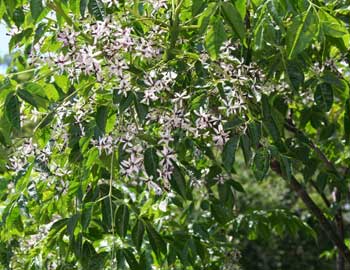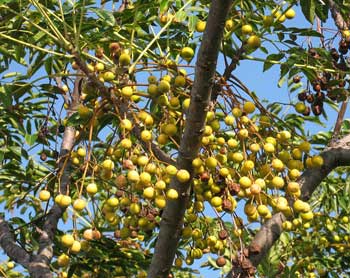Contents:
Common Names | Parts Usually Used | Plant(s) & Culture | Where Found | Medicinal Properties
Uses | Bibliography
Scientific Names
 |
- Melia azedarach L.
- Mahogany family
Common Names
- Azedarach
- Africa lilac
- Bead tree
- China-berry
- China-tree
- Hagbush
- Hop-tree
- Pride of India
- Pride tree
- Sen-shu (Chinese name)
Parts Usually Used
Root bark, fruit
Back to Top
Description of Plant(s) and Culture
 |
Pride of China is a deciduous tree; grow to 40 feet high or more, the thick trunk has spreading branches and is covered with furrowed bark. The alternated, bipinnate leaves are from 1-3 feet long and have numerous pointed, sharply serrate or lobed leaflets that range in shape from ovate and elliptic to lanceolate. The purplish, fragrant flowers grow in long-peduncled panicles, blooming in early spring. The fruit is a nearly round, yellow drupe from 1/2 to 3/4 inch across.
Back to Top
Where Found
Native to southwestern Asia but widely cultivated and naturalized in the West Indies and the southern United States.
Back to Top
Medicinal Properties
Anthelmintic, astringent, bitter tonic, emetic, emmenagogue, purgative
Back to Top
Uses
Root bark acts as a purgative or emetic, especially in large doses. Also said to promote the onset of menstruation. In India, the bark of the tree, bitter and astringent, is used as a tonic. The seeds and oil of the fruit promote the elimination of intestinal worms. The tree also exudes a gum which has been considered by some to have aphrodisiac powers.
Back to Top
Bibliography
![]() The Herb Book
The Herb Book, by John Lust, Bantam Books, 666 Fifth Avenue, New York, NY. copyright 1974.
![]() Chinese Medicinal Herbs
Chinese Medicinal Herbs, compiled by Shih-Chen Li, Georgetown Press, San Francisco, California, 1973.
![]() Webster’s New World Dictionary
Webster’s New World Dictionary, Third College Edition, Victoria Neufeldt, Editor in Chief, New World Dictionaries: A Division of Simon & Schuster, Inc., 15 Columbus Circle, New York, NY 10023
